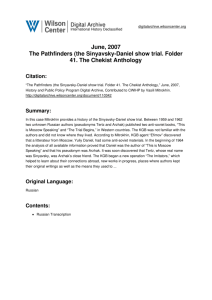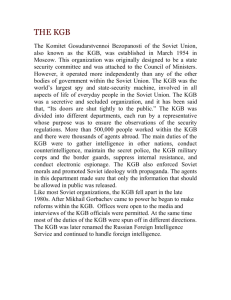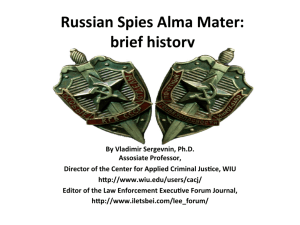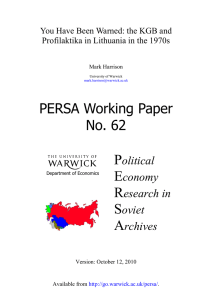State-Security Clearance as an Instrument Lithuania, 1965 to 1985
advertisement
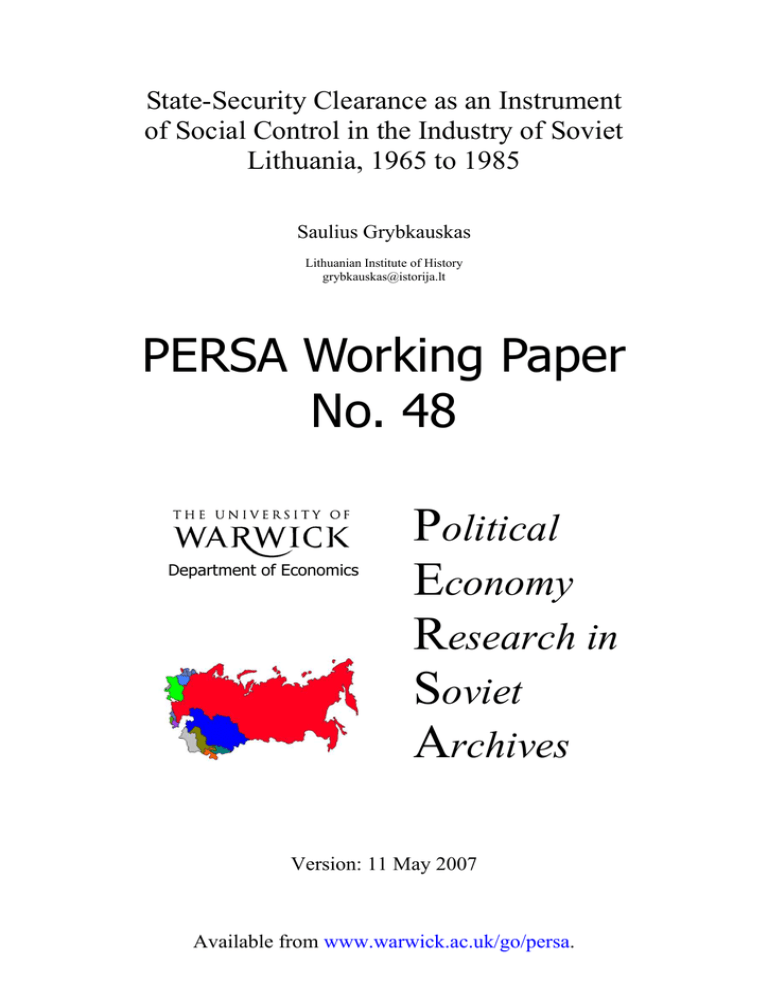
State-Security Clearance as an Instrument of Social Control in the Industry of Soviet Lithuania, 1965 to 1985 Saulius Grybkauskas Lithuanian Institute of History grybkauskas@istorija.lt PERSA Working Paper No. 48 Department of Economics Political Economy Research in Soviet Archives Version: 11 May 2007 Available from www.warwick.ac.uk/go/persa. State-Security Clearance as an Instrument of Social Control in the Industry of Soviet Lithuania, 1965 to 1985 Saulius Grybkauskas As an authoritarian regime, the Soviet system had two levers of social control: patronage, through promotion to the nomenklatura (the list of official positions to which appointment required party approval); and repression.1 However, there was more than one nomenklatura, and there were other forms of repression than arrest and punishment. These also had major influence on individual social and professional mobility. One such instrument was the granting or withholding of clearance by the KGB, the USSR committee of state security, to persons for work involving secret documents in workplaces such as factories and offices. The granting of this clearance (dopusk) could be thought of as a kind of patronage. On the other hand, refusal of KGB clearance was a form of repression. The KGB clearance system was well suited to the ideological doctrine of "mature socialism" in the Brezhnev period. The hypothesis of mature socialism did not allow for the existence of enemy classes or social groups, which were supposed to have been defeated in the previous period of history. The KGB documents of the Brezhnev era occasionally refer to a "remainder of enemy elements" but such references are not frequent. Unreliable people were mostly categorized as "politically unstable." The clearance system helped the regime to detect politically unreliable people and to impede their careers. Formally the clearance system was established to protect the secrets of the Soviet state from the intelligence services of the NATO states. But the clearance system may also be seen as an instrument of social control because 1 This paper was presented to the conference on "Latvia and Eastern Europe in the 1960s to 1980s" held in Riga on 10 October 2006. The author is a PhD student in the Lithuanian Institute of History, working on "The Management of Industry in Soviet Lithuania during 1965 to 1985: Tensions and Conflicts." 2 it subjected those who were identified as politically unreliable to restrictions on mobility and career. Thus, the formal need to protect state secrets was transformed into broader control of society. How did KGB clearance operate? What kinds of work were classified as "secret"? How was the nomenklatura of secret employment organized and authorized within the KGB? How did the KGB check the fitness of employees for positions involving work with secrets? During the two decades from the mid-1960s to the mid-1980s, legislation was supplemented by two instructions that ensured state security. Instruction no 0015-1965 of 1965 was amended by a further instruction 00166-72 in 1972. Scientific works and documents could be classified into most secret (matters of "special importance," osoboi vazhnosti), "top secret" (sovershenno sekretno), or merely "secret." But the instructions did not clarify the criteria for classification. The primary list of state secrets (Perechen' glavneishikh svedenii, sostavliaiushchikh gosudarstvennuiu tainu) was established directly by a resolution of the USSR Council of Ministers; this was complemented by other ministerial lists that existed in parallel. The primary list was set out in 1966 and remained in force until 3 December 1980 when it was next revised.2 The ministerial lists could also classify positions and documents as of "special importance," "top secret," and "secret."3 Corresponding to the different levels of secret classification were three levels of KGB security clearance: form no. 3 gave access to "secret" matters, no. 2 to "top secret" matters, and no. 1 to matters of "special importance." The list of positions in each enterprise that required security clearance at each level was put forward by the enterprise's "secret" (usually "first") department," and was checked and confirmed by the KGB. This was followed by the vetting of existing and newly appointed personnel. The enterprise secret department applied for clearance to the KGB third department. This involved a 2 , Special Archives of Lithuania (hereafter LSA), fund K-1, collection 46, file 2159, page 4 (USSR Council of Ministers Resolution of 3 December 1980). 3 LSA, K-1/46/2155, 1-7 (extract from USSR Council of Ministers Resolution of 11 November 1972, "Instructions on the maintenance of state security and the regime of secrecy"). 3 KGB operative checking the employee's personal characteristics in order to establish his capacity to uphold state secrets. Evidence was taken from local KGB offices and from the KGB and state archives, and included both the person's biographical data and information about his social background and family members. The certificate completed by the KGB territorial department and State archives was kept in the person's KGB clearance file together with information obtained by the KGB from its network of agents. On the basis of this information, the KGB operative prepared a report that recommended to his superiors the grant or denial of clearance at the level requested. In contrast to the outcome under a democratic form of government, under the Soviet security system the employee was not permitted to be informed of the KGB decision to grant or deny clearance. Typically, employees who were denied clearance believed that they were under suspicion for some offence. In most cases employees thought that they were suspected of something by "the organs" and this situation tended to raise their frustration. The records of the second directorate of the KGB of Soviet Lithuania for 1979 show that 14,000 people had been granted clearance at the highest or second levels in Lithuania.4. The number of clearances issued in factories and other organizations depended on whether or not the enterprise fell within the defense industry, on its "regime status," and on what it produced. The television factory in Šiauliai, for example, came under the defense industry because it was subordinated to the USSR Ministry of the Radio Industry. From 1974 this factory had the regime status of an "open organization with closed subunits." In 1984, clearances were issued to 1,070 employees.5. Employees of the defense industry factories described above were not the only ones that had to seek clearance from the KGB. Many top managers of civilian branches also had to seek clearance. For example, 55 people had clearance in the Neris agricultural machinery firm. This was only 2 percent of the 2,580 employees in 1984. Still, the need for clearance applied to all the top managers of the 4 LSA, K-1/3/759, 85 (Lithuanian SSR KGB, second directorate, report of work in 1980). 5 LSA, K-1/46/2115, 114 (LSSR KGB, third department, operational plan of work in the Television Factory in Šiauliai in 1984). 4 company: the director and all the deputy directors, heads of departments, and chiefs of workshops and technical bureaus.6 Managers of civilian factories who had to visit the premises of defense enterprises and delivered to or were supplied by them also had to seek clearance from the KGB. This is why the overall number of clearances tended to rise in the republic and why the denial of clearance could restrict promotion even in civilian branches. The local KGB objective of enlarging the list of enterprises that it served operationally had the support of the Communist Party bodies in Lithuania. The long list of factories reporting to the KGB, confirmed by the local party, is evidence of the local party's interest in widening the scale of KGB activities within enterprises and in encompassing a growing number of enterprises. In contrast, the KGB centre in Moscow accused its republican subordinates of dissipating attention onto enterprises lacking any "regime status". In the opinion of the centre, KGB intervention in civilian branches was necessary only in cases involving sabotage. It does not follow that there was a simple division between the Soviet Lithuanian nomenklatura that wanted intense KGB control over the whole of society, and the Soviet KGB centre that wished to restrict its responsibility to the security of military production alone. This question has deep roots in both the economic system and federal institutions of the Soviet era. The republican nomenklatura wanted to prevent any display of nationalism in the republic, in its enterprises and organisations. Its political fate rested on the capacity of the local institutions to suppress nationalism; in the event of a nationalistic upheaval, Moscow would inevitably undertake a purge of the local cadres. In other words, the local KGB's bureaucratic objectives were aligned with the local nomenklatura's political instinct for survival. The result of this confluence of interests was the transformation of the clearance system into a powerful instrument of social control. The KGB's industrial specialists formulated the basis of their activity in the following rather original way: it was necessary for the KGB to guard industrial enterprises against "nationalist 6 LSA, K-1/46/2113, 24-31 (LSSR KGB, third department, certificate of operational conditions in the Neris factory, 1984). 5 elements." It was necessary to persecute nationalists not only because of their outlook, but also because of their tendency to express this outlook in their behaviour through sabotage. The presence of "nationalist elements" in the factories was said to go hand in hand with the dangers of sabotage and diversion. In a survey of sabotage a KGB officer V. Bunin wrote: "Sabotage is a deliberate form of the imperialist intelligence work of disruption. It can be done by people: 1) imperialist agents, 2) bourgeois nationalists, and 3) antiSoviet cross-eyed persons."7 Thus, a person whose biography contained compromising data was considered to be a bourgeois nationalist and antiSoviet person influenced by Western ideological and intelligence activity that could amount to an act of sabotage. This was one reason why KGB vetting of a person's suitability was often based on biographical factors. The so-called nationalist elements in an enterprise became known as the "operational base". The "base" was an important factor describing the operational situation in the enterprise. From this starting point, counter-intelligence plans for work in the factory were prepared by the KGB operational officer. The contingent of politically unreliable people in the enterprise was the pretext for the KGB to open a "code-letter file" (liternoe delo) for the enterprise that collected and systematised information about security condition, plans for conserving secrets, agent networks, and reports from agents. Despite its assumptions about the role of politically unreliable people in sabotage in the factories, the KGB did not find clear evidence of these acts. Nationalist sabotage was the hypothesis that supported KGB activity, but it was not the reality. This suggests that the main purpose of KGB activity was not in fact the investigation of sabotage or security conditions but the suppression of nationalism. In 1971, for example, the KGB third department reported that during the year the department had received 42 warnings of inadequate security in the factories, and 33 warnings of possible reasons for its breakdown. Most signals that reached the department concerned nationalistic 7 LSA, K-1/46/797, 12 (survey by KGB officer V. Bunin). 6 anti-Soviet speeches made within enterprises – 69 cases8. In 1983 and 1984 the Vilnius "industrial group" of the KGB third department examined 43 warnings, of which 85 per cent concerned "ideological diversion."9. In many cases, therefore, the scope of the KGB third department overlapped with that of its fifth service (ideological counter-intelligence). The fifth service concentrated its ideological counter intelligence work on the intelligentsia, while the third department worked on the industrial enterprises, using the clearance system to fulfil its role. The KGB's coverage of politically unreliable people became more detailed and comprehensive in the late 1960s and early 1970s. According to an estimate that the Soviet Lithuania KGB second directorate reported in January 1966, some 20,000 former prisoners were living in the republic who had been sentenced for political reasons in the Stalin period, for example participation in the anti Soviet partisan resistance, and had returned to Lithuania during the Khrushchev years.10 The clearance system was well designed to detect such people when they appeared amongst the managerial stratum. On 19 June 1968, the KGB of the Lithuanian SSR adopted a resolution on the need to intensify its efforts among "the remainder of enemy elements"11. A month later the head of the fifth service Ščensnovičius wrote to the head of the third department Akimov: "Investigations carried out by a source of information let us state the fact that we have no information about the political feelings, disposition, ambitions, lifestyle, localities of concentration, economic and living conditions of these people."12. To implement this resolution, the third department produced statistical data about politically unreliable people working in industry, transport and 8 LSA, K-1/3/682, 278 (LSSR KGB, third department, report of work in 1971). 9 LSA, K-1/14/21, 65 (KGB, Vilnius city department, report of work in 1983-1984). 10 LSA, K-1/3/644, 3 (LSSR KGB, second directorate, certificate issued 5 January 1966). 11 LSA, K-1/3/664, 182 (head of LSSR KGB fifth service M. Ščensnovičius, letter to head of third department Akimov dated 12 July 1968). 12 Ibid. 7 communication establishments.13. These divided the former political prisoners and deportees into three groups. According to the security sources, most of these people had been integrated into Soviet society and now "conformed to work of social utility". Another group of people that had a nationalistic mindset was trying to demonstrate loyalty to Soviet government. The third group, according to the KGB, consisted of people who, "under the pretext of problems in the enterprises and administrative mistakes, sought to incite various politically unstable citizens to antisocial escapades."14 This report of the third department was the last KGB document to reveal "liberal" attitudes to politically unreliable people. At the end of the 1960s the KGB evaluation of them changed substantially. In 1972, by order of J. Petkevičius, chairman of the Lithuanian SSR KGB, the heads of local agencies of the KGB were warned to be more watchful in view of cases where people against whom seriously compromising data had been collected had tried to take up important jobs or had became leaders of the national economy. A more severe attitude to politically unreliable people is clearly felt in KGB reports from the countryside. In 1968. for example, the local KGB organisation reported that 563 former political prisoners lived in the provincial town of Panevežys. According to the report, most of these people employed in industrial and construction organisations were proving themselves to be good and reliable workers. They worked "particularly honestly" so some of them now occupied high positions including managers of enterprises. Thus Bonifacas Sutulas and Klimavičius were department and workshop heads in the "Ekranas" Cinescope factory, and Gasiūnas was deputy-director at the giro-compressor factory in Panevežys15. This evaluation of former political prisoners was notably reversed in later reports. In 1970 it was reported to the fifth department of the KGB that there were 560 former political prisoners living in Panevėžys; "most of them have no special education, necessary qualification, or specialisation, but still they seek to occupy materially 13 LSA, K-1/3/664, 154 (certificate of third department). 14 Ibid, page155. 15 LSA, K-1/14/603, 1-4 (KGB, Panevėžys city department, report of work in 1968). 8 responsible and well-paid positions." This tendency was presented quite differently from the previous report: "All such people do their best in profiteering and subservience, and try to avoid political discussions as well as obvious relationships with their accomplices from the deportation camps."16 According to the city KGB, the career and material wealth of the former political prisoners "evoke the resentment of honest Soviet citizens and their ideological doubt." Vetting procedures were said to be helpful in detecting politically unreliable people and putting an end to their career advancement. The KGB annual report for 1978 states, for example: "in the process of vetting a group of people with compromising data has been uncovered. Some of them have been placed under observation for further investigation."17 From KGB reports we can identify a stable ratio of clearance refusals to checks. In 1973, 4,584 persons were vetted by the Lithuanian SSR KGB third department: 333 at the first, 1,897 at the second, and 2,027 at the third level. Of these , 321 were denied clearance and six clearances issued in advance were cancelled18. Thus, of all those checked seven per cent were refused. We find the same ratio in the third department's 1981 report of work: 895 persons were cleared and 67 were refused clearance.19 At first sight, therefore, on the basis of a seven percent refusal rate, the clearance system does not appear to have been very coercive. However, the refusal of clearance gravely affected the careers of politically unreliable people. For example, during the KGB vetting campaign in 1976 three chief engineers of the three biggest industry enterprises in Kaunas (the position of chief engineer of the enterprise in Soviet times was second in line after the 16 LSA, K-1/14/604/64, 65 (KGB, Panevėžys city department, reply to letter from Ščensnovičius dated 28 November 1969). 17 LSA, K-1/ 3/749, 182 (third department, report of operational work in 1978). 18 LSA, K-1/3/717, 7 (third department, report of work in 1973, dated 3 January 1974). 19 LSA, K-1/3/755/134 (third department, report of operational work in 1981). 9 director) lost their clearance and subsequently their jobs.20 The significance of clearance denial is illustrated by the example of one Dučinskas. This person was a leading manager of the Vilnius radio component factory. Until the beginning of 1970s he occupied the position of deputy-director for production. In 1968 a big clearance campaign was launched against the politically unreliable people. It then emerged that Dučinskas was of bourgeois social origins. This KGB discovery not only halted his career but threatened him with dismissal from his high position. Former director of the factory A. Linartas wrote in his memoirs that he tried for some years to retain Dučinskas in his position as deputy director against KGB pressure but eventually had to demote him to deputy chief engineer because this position did not require KGB clearance.21 As a system of social control, vetting extended beyond the direct denial of clearance. It also exerted an indirect influence. While engaged in vetting, the KGB might identify a group of people against whom there were compromising data, but decide to issue them with clearances anyway. In its report of 1976, for example, the Kaunas city KGB noted that 120 employees of the city enterprises and organizations were issued with clearances despite the existence of compromising data.22. This was not exceptional against the background of evidence relating to the republic as a whole; in 1982, the second directorate of the Lithuanian SSR KGB reported that in the republic there were one thousand employees with first- or second-level clearance on whom compromising data were held.23 The KGB paid considerable attention to this type of person. Thus the Panevėžys city KGB wrote in its plan for 1978 that deputy-director Liutackas of the precision mechanics factory had received clearance despite 20 LSA, K-1/14/170, 10 (KGB, Kaunas city department, certificate of work under the second directorate in 1976). 21 S. Grybkauskas and A. Linartas, Vilniaus Vingis istorijos vingiuose (Vilnius, 2004), p. 261. 22 LSA, K-1/14/169, 10 (KGB, Kaunas city department, report of operational work in 1976). 23 LSA, K-1/ 3/ 773/ 9 (LSSR KGB, second directorate, report of work in 1982). 10 compromising data in his file. According to this plan, Liutackas was under surveillance by two KGB agents.24 A second aspect of the indirect influence of the clearance system was that politically unreliable people were deterred from seeking further promotion. It is difficult to prove this dimension of KGB power from research in the archives. The moment at which individuals abandoned their goals could more easily be ascertained by anthropological techniques including interviews and surveys of which historians should make wider use. Of course, politically unreliable people themselves did not know exactly how the KGB clearance system worked but we can speculate that these people must have had some presentiment that prevented them from further building their careers. They were likely to sense that an application for promotion would be followed by more scrupulous KGB checking of their biographies. In the event of compromising evidence being found, they could lose their present positions and thus end up worse off. In an interview, for example, the former chief of the Vilnius radio component factory design bureau A.Valančius claimed that he had opportunities to improve his career but was held back by fear of what examination of his biography might uncover. Formally, the KGB clearance system was created to maintain state secrets. In reality it was transformed into a large-scale system of social control which, during the Brezhnev period of "mature socialism," was instrumental to the regime for inhibiting the social mobility and career prospects of politically unreliable people and the scope for nationalist expressions. The clearance system formed a complex unity with other KGB means of control over society. 24 LSA, K-1/14/611/142 (KGB, Panevėžys city department, plan of operational work in 1978).
